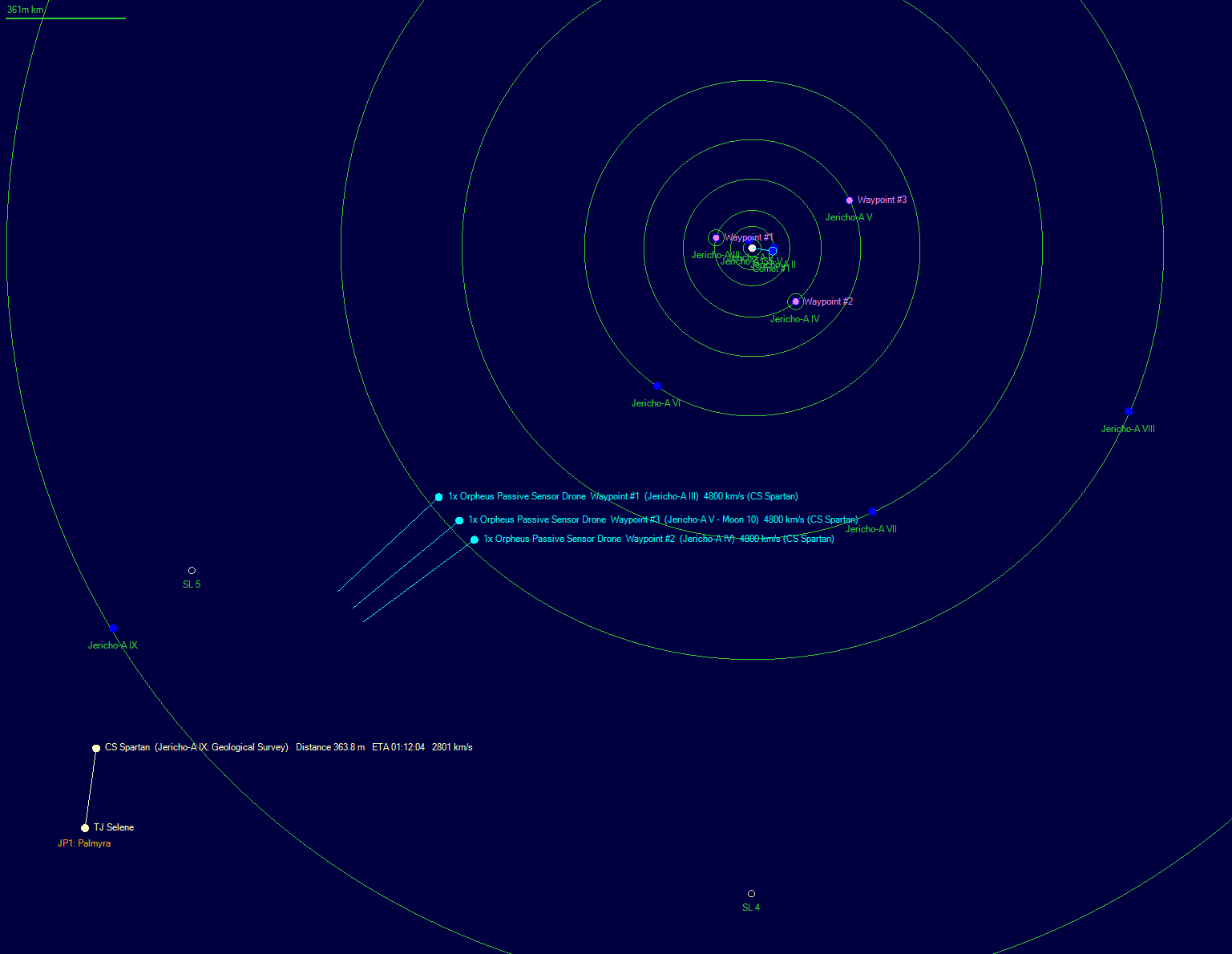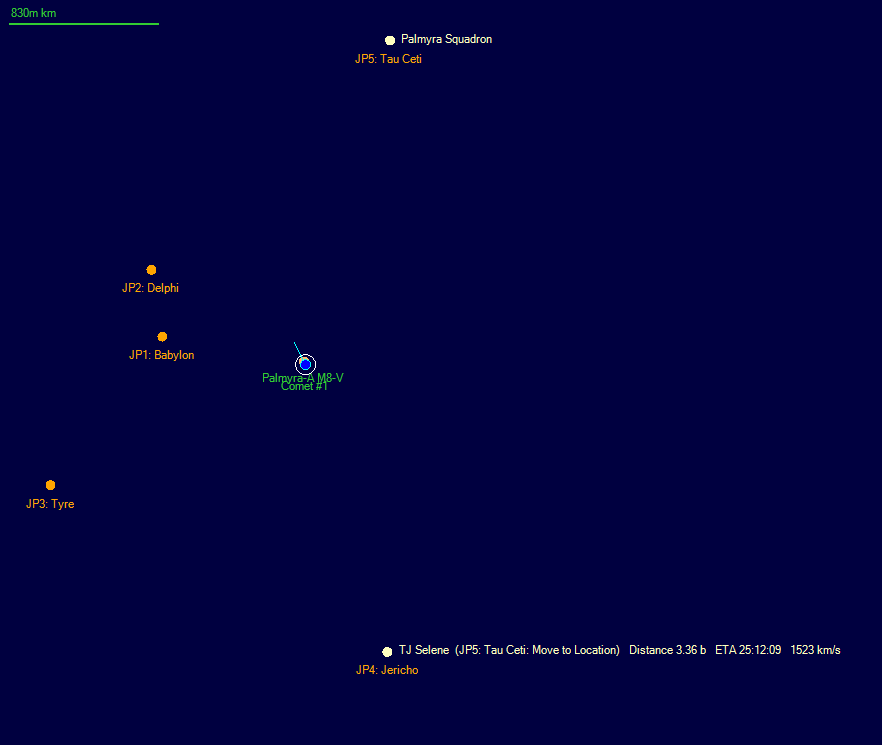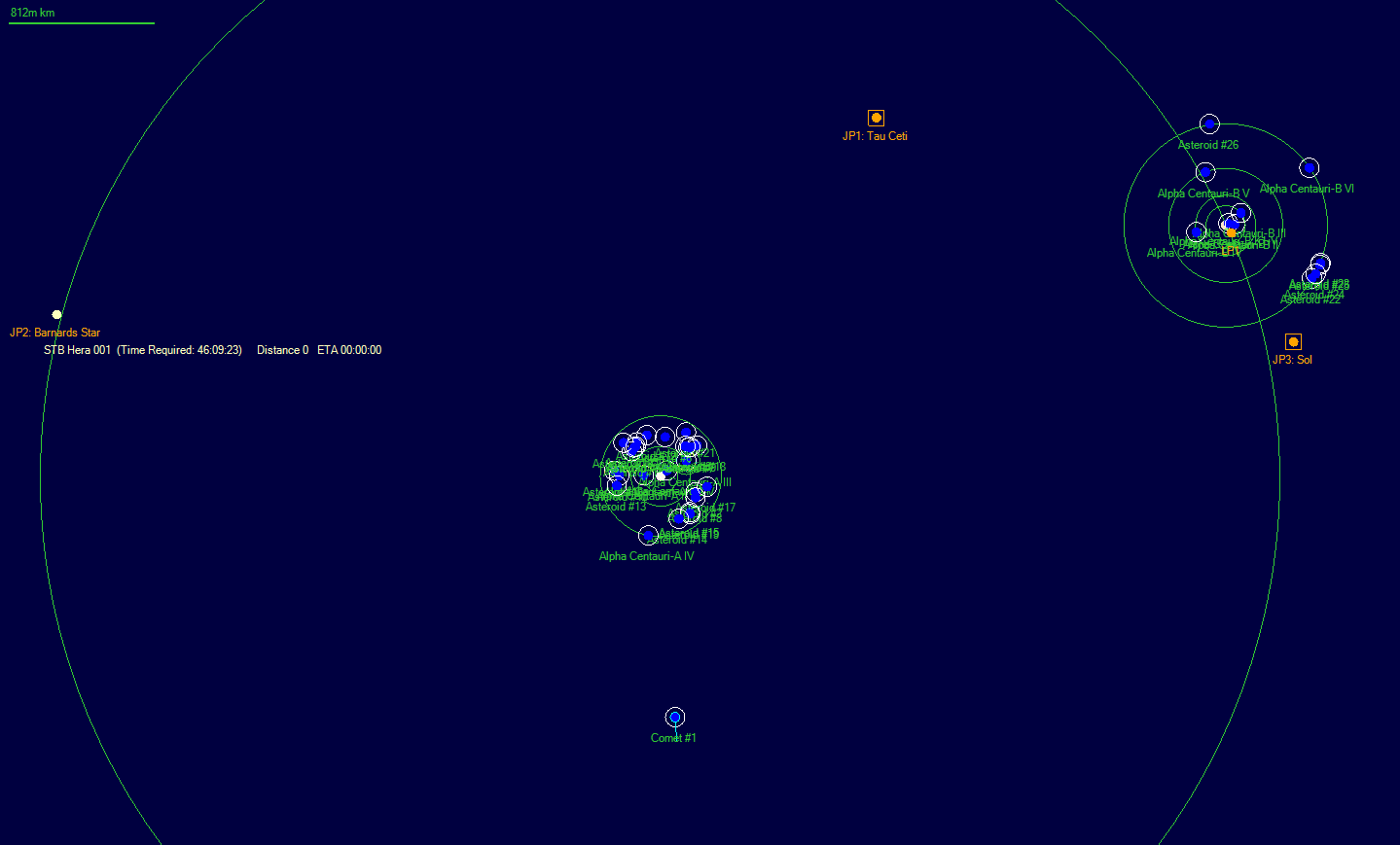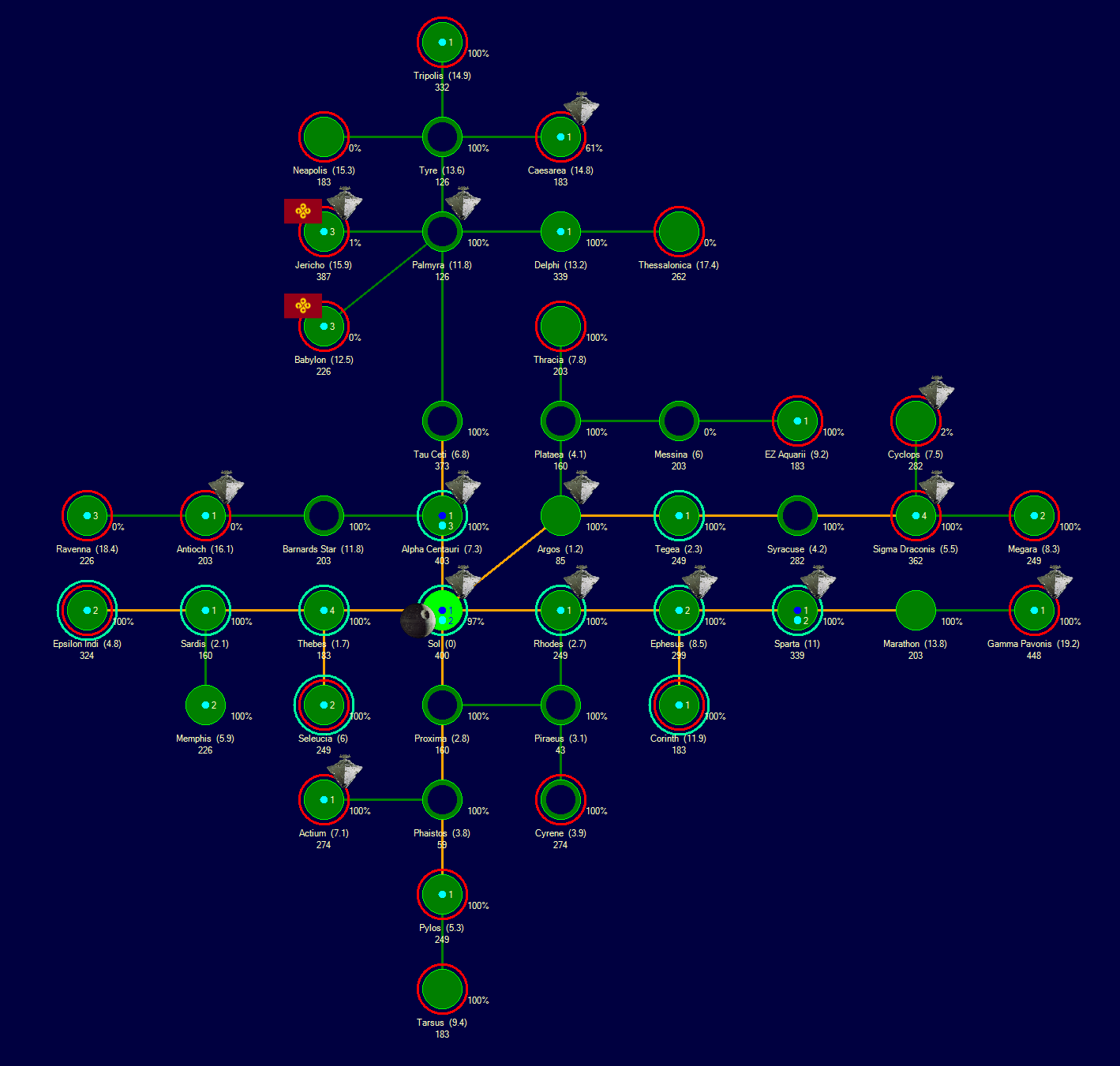The brief geological survey in Tyre was accomplished within incident, so
Spartan and
Selene moved through Palmyra and transited the Jericho jump point. Jericho was a yellow G5-V star with eleven planets and over a hundred moons. Two planets and one of the moons had nitrogen – oxygen atmospheres, with colony costs between 2.00 and 2.11. After the loss of
Sybille in Babylon and the subsequent brief engagement of the expeditionary force, the standard procedure for investigating new systems had been changed. The Apollo and Scylla class survey cruisers were equipped with two Mk I naval torpedo launchers, primarily intended for self-defence. Every survey cruiser carried eighteen Perseus torpedoes for those launchers, plus four Orpheus passive sensor drones. The Orpheus had never been used operationally as the geological survey cruisers had directly investigated each new world and had been regarded by the survey crews as a waste of magazine space. With the new threat presented by the aliens in Babylon, now generally referred to as the Babylonians, the Orpheus was far more appreciated. Before leaving the jump point,
Spartan launched drones at the third and fourth planets and the tenth moon of the fifth planet.
Apollo class Survey Cruiser 9,000 tons 231 Crew 1,123.2 BP TCS 180 TH 504 EM 0
2801 km/s JR 3-50 Armour 2-38 Shields 0-0 HTK 57 Sensors 2/2/3/0 DCR 8 PPV 10
Maint Life 4.01 Years MSP 624 AFR 81% IFR 1.1% 1YR 62 5YR 930 Max Repair 158.2 MSP
Magazine 112
Captain Control Rating 1 BRG
Intended Deployment Time: 36 months Morale Check Required
Tesla TJD-9000 Military Jump Drive Max Ship Size 9000 tons Distance 50k km Squadron Size 3
Parsons PN-250E Triple Expansion Ion Drive (2) Power 504 Fuel Use 18.94% Signature 252 Explosion 7%
Fuel Capacity 725,000 Litres Range 76.6 billion km (316 days at full power)
Mk I Naval Torpedo Launcher (2) Missile Size: 5 Rate of Fire 25
Maxwell MF-36 Torpedo Fire Control (1) Range 36.1m km Resolution 120
Orpheus Passive Sensor Drone (4) Speed: 4,800 km/s End: 12d Range: 5,229m km WH: 0 Size: 5
Perseus Torpedo (18) Speed: 19,200 km/s End: 29m Range: 33.7m km WH: 9 Size: 5
Maxwell MX-36 Area Surveillance Sensor (1) GPS 4320 Range 37.3m km Resolution 120
Rutherford RT-2 Passive Thermal Sensor (1) Sensitivity 2 Detect Sig Strength 1000: 11.2m km
Rutherford RE-2 Passive EM Sensor (1) Sensitivity 2 Detect Sig Strength 1000: 11.2m km
Gravitational Survey Sensors (3) 3 Survey Points Per Hour

On January 9th 1894, the Orpheus drone heading for Jericho III was destroyed by a strength-1 detonation two million kilometres from the planet.
Spartan immediately abandoned her survey of the ninth planet and set course for the jump point.
Selene, already on the jump point, transited into Palmyra to warn Captain Bowen’s picket squadron on the Tau Ceti jump point. The contact report was quickly relayed all the way back to Earth. Another message was sent via the tanker
Thesmophoros on the Palmyra - Delphi jump point to
Tribune and
Intrepid, who were conducting a gravitational survey of that system and had found one new jump point so far.
The discovery of a hostile force in a second system meant either the Babylonians were already a multi-system empire with knowledge of jump points, or there were two hostile alien races within four jumps of Sol. Neither prospect was very appealing. The Admiralty ordered
Spartan and
Selene to pull back to the Tau Ceti jump point, but left
Tribune and
Intrepid to continue their work. The Jericho jump point was the furthest from Tau Ceti while Delphi was the closest and so far there was no sign of any alien presence in the latter system or in Tyre. While the Tau Ceti jump point was the only known route to Empire space, the Admiralty wanted to know if other jump points in the area around Palmyra might lead to a different part of the Empire.

Shipbuilding had been recently increased, due to a small improvement in the mineral situation, so three Majestics, two Diadem and two Pelorus were under construction. Research was underway into energy weapons and the associated fire control systems so the Admiralty hoped to support their main combatants with a new laser-armed cruiser class, but that was still some years away. The most immediate need was for a scout that could learn more about the strength of the alien forces. The Apollo and Scylla class cruisers were not suitable for solo operations in the face of hostile warships, while the Admiralty was becoming increasingly concerned about risking too many front-line warships without more intelligence on what they might face. For the moment, the Admiralty wanted to maintain strategic defence and conduct aggressive reconnaissance. The problem was a lack of suitable light forces to accomplish the latter task.
Faced with this dilemma, the Admiralty turned to Hiram Maxim, an American inventor who moved to Great Britain in 1881. Maxim had used the availability of declassified British Trans-Newtonian technology to realise his dream of powered flight and form his own aircraft production company. Maxim-designed aircraft were popular for civilian travel on Earth. Since the dawn of the interstellar age, Maxim had been advocating the use of small, low cost craft for many deep space tasks, rather than tying up the large and expensive spacecraft of the Royal Navy and the Royal Fleet Auxiliary. He had proposed a 500-ton scouting design on the basis that it would be difficult for any hostile force to detect. This had been dismissed by the Admiralty until they realised the proposed scout could be a solution to their current problem.
The Maxim Zephyr design included similar EM and thermal sensors to the Royal Sovereign class battleships, as well as an active sensor with a range of twenty million kilometres. However, the range was relatively short, enabling it to function well within a single star system but restricting long-distance travel. In addition, there was no on-board engineering deck, which prevented in-flight repair and limited the Zephyr to either short flights or a risk of critical failure. To be most effective, the Zephyr would have to be transported to the target system. Finally, the Zephyr was relatively slow, which would give it little chance to escape if detected. The Admiralty believed the Zephyr concept could meet their requirements and therefore decided to recall and modify the survey cruiser
Apollo to carry the Zephyr for an operational test. The Apollo’s torpedo launchers, magazine and fire control would be replaced with a small hangar deck and additional fuel for the Zephyr.
Maxim Zephyr class Scout 500 tons 17 Crew 75.6 BP TCS 10 TH 24 EM 0
2425 km/s Armour 1-5 Shields 0-0 HTK 6 Sensors 10/12/0/0 DCR 0 PPV 0
Maint Life 0 Years MSP 0 AFR 98% IFR 1.4% 1YR 10 5YR 153 Max Repair 20 MSP
Lieutenant Commander Control Rating 1 BRG
Intended Deployment Time: 0.5 months Morale Check Required
Maxim Naptha-24 (1) Power 24 Fuel Use 178.89% Signature 24 Explosion 10%
Fuel Capacity 50,000 Litres Range 10.2 billion km (48 days at full power)
Maxwell MX-20 Navigation Sensor (1) GPS 1440 Range 21.6m km Resolution 120
Rutherford RE-12 Passive EM Sensor (1) Sensitivity 12 Detect Sig Strength 1000: 27.4m km
Rutherford RT-10 Passive Thermal Sensor (1) Sensitivity 10 Detect Sig Strength 1000: 25m km
Apollo-S class Survey Cruiser 9,000 tons 207 Crew 1,096.5 BP TCS 180 TH 504 EM 0
2801 km/s JR 3-50 Armour 2-38 Shields 0-0 HTK 54 Sensors 2/2/3/0 DCR 8 PPV 0
Maint Life 3.96 Years MSP 609 AFR 81% IFR 1.1% 1YR 62 5YR 928 Max Repair 158.2 MSP
Hangar Deck Capacity 500 tons
Commander Control Rating 1 BRG
Intended Deployment Time: 36 months Flight Crew Berths 40 Morale Check Required
Tesla TJD-9000 Military Jump Drive Max Ship Size 9000 tons Distance 50k km Squadron Size 3
Parsons PN-250E Triple Expansion Ion Drive (2) Power 504 Fuel Use 18.94% Signature 252 Explosion 7%
Fuel Capacity 910,000 Litres Range 96.2 billion km (397 days at full power)
Maxwell MX-36 Area Surveillance Sensor (1) GPS 4320 Range 37.3m km Resolution 120
Rutherford RT-2 Passive Thermal Sensor (1) Sensitivity 2 Detect Sig Strength 1000: 11.2m km
Rutherford RE-2 Passive EM Sensor (1) Sensitivity 2 Detect Sig Strength 1000: 11.2m km
Gravitational Survey Sensors (3) 3 Survey Points Per Hour
On May 6th 1894, the refitted
Apollo, carrying the first Maxim Zephyr, arrived in Palmyra. Marcus Bowen, recently promoted to commodore but still retaining command of the Ariadne and the Palmyra Squadron, ordered
Apollo to transit the Jericho jump point and send the Zephyr on a reconnaissance mission towards Jericho III. Meanwhile in Delphi, also adjacent to Palmyra,
Tribune and
Intrepid completed their gravitational survey, finding a single jump point. Both ships moved to investigate and discovered Thessalonica, an unremarkable red dwarf system. Unwilling to let the survey ships move too far from assistance, especially as it would stretch the communication chain by one more jump point, Commodore Bowen relayed a message via the tanker Thesmophoros ordering the ships to pull back into Palmyra.
Tribune was due for an overhaul so she left on the long journey back to Earth while
Intrepid and
Thesmophoros headed for the Palmyra – Tyre jump point. The tanker would hold position on the jump point while
Intrepid surveyed the system.
The Zephyr slowly closed in on Jericho III. On June 4th, thirty-six million kilometres from the planet, the scout detected three strength-2591 thermal signatures breaking orbit and moving in her direction at 5476 km/s. Based on the signatures, the three ships were all the same type, confirmed as Babylonian and designated as Daemon class. Lieutenant Commander Harry Hawkins, a daring and cheerful individual who commanded the Zephyr’s 17-man crew, relayed this information to Commander Michael Brooks of the
Apollo, waiting on the jump point. Brooks immediately ordered Hawkins to retreat before taking his own ship into Palmyra to inform Commodore Bowen. Both Bowen and Brooks were aware the Royal Sovereign class battleship had a thermal signature of strength-1200 thermal signature, less than half that of the alien Daemon class. While the higher speed of the alien ships would contribute to that thermal signature, it was now obvious the aliens had larger and faster ships than the Royal Navy, which did not bode well for the chances of young Hawkins and his slow-moving 500-ton scout.
The thermal signature of the Zephyr was only strength-24, so given its small cross-section Lieutenant Commander Hawkins found it difficult to understand how the Babylonians had detected his ship. Either their sensor technology was far in advance of the Empire, or they had specialised sensors for detecting small ships. In any event, the Zephyr had little option but to run for the jump point. There was no longer any need for stealth, so Hawkins activated his ship’s Maxwell MX-20 Navigation Sensor, which had a range slightly over twenty million kilometres. There were no active contacts within range. Thirteen minutes after contact, Zephyr’s thermal sensors detected four small contacts at a range of two point seven million kilometres, inbound at 44,000 km/s. Commander Brooks and the crew of
Apollo, monitoring the relayed signal, watched the single torpedo salvo draw inexorably closer until suddenly the icon of the Zephyr was replaced by four strength-6 detonations and a wreck marker. Only four of the seventeen crew made it to a life pod. Lieutenant Commander Hawkins was not among them. With the three alien battleships nearby, there was no way for
Apollo to mount a rescue, so she remained on the jump point to maintain contact with the stranded crewmen and to relay messages to their families back on Earth. On June 20th, their life support ran out and
Apollo transited back into Palmyra. Commodore Bowen ordered the ship into Tyre to support the survey of Intrepid.
Two weeks later a new squadron, comprising the class heavy cruisers
Argonaut and
Diadem and the light cruisers
Prometheus and
Proserpine, arrived in Palmyra to relieve Commodore Bowen’s force.
Ariadne,
Niobe,
Pegasus,
Perseus and
Thetis headed for Sol for resupply and overhaul. The new Palmyra squadron would be temporarily without a jump ship until a survey cruiser arrived from Sol to take on the role covered by
Thetis.
Sustaining a squadron in Palmyra took a toll on crews and resources so, after consulting with the civilian authorities, Sir Frederick Richards decided to begin preparations for a different approach to the defence of the Empire against the Babylonians. The Nova Terra colony on Alpha Centauri-A III was initially dismissed as a base location, due to the distance from Palmyra and even from the Tau Ceti jump point. However, the Alpha Centauri B solar system was close to the Sol jump point and moving in the general direction of the Tau Ceti jump point, so it was a far better option. In addition, if the jump point defence was mounted at the Alpha Centauri – Tau Ceti jump point with a single scout holding position at the Palmyra – Tau Ceti jump point, the squadron could remain at a base in that solar system and move into a defence posture after receiving a warning. The recent stabilisation of the Alpha Centauri – Tau Ceti jump point made that warning easy to transit. Therefore, the Toliman Colony was established on the second moon of Alpha Centauri-B III to act as forward naval base. The moon lacked atmosphere or water, but did have acceptable gravity so normal infrastructure was sufficient. Colony ships began work immediately, creating a workforce for planned maintenance facilities. Construction factories on Sol added a refuelling station to the list of future projects. The Palmyra Squadron would remain in place until the facilities were ready and then pull back to Alpha Centauri, leaving a jump tender in Palmyra as the forward picket.

Meanwhile,
Apollo and
Intrepid completed their survey of Tyre in early September, locating three new jump points which led to the systems of Tripolis, Caesarea and Neapolis. Tripolis was an orange K-class star with a single, small terrestrial world, while Caesarea and Neapolis were both red dwarf binaries with an unremarkable collection of planets, moons and asteroids. With a plan in place to withdraw from the area around Palmyra, the Admiralty saw no point in searching for jump points in the new systems.
Apollo and
Intrepid were ordered to pull out, with
Intrepid being assigned as jump support for the Palmyra Squadron, while
Apollo returned to Sol for resupply, before heading through Rhodes and Ephesus to the Corinth system to begin a new survey. The geological ship
Spartan, supported by the jump tender
Selene, headed in the opposite direction, surveying the planet in Tripolis before moving on to Caesarea.
Even with the strategic withdrawal from the Palmyra area, there was still a need for intelligence on the Babylonian force in Jericho. It was too strong for a reconnaissance in force and both the Maxim Zephyr and the Orpheus sensor drone had proved ineffective. Robert Whitehead, the chief designer for the Royal Navy’s torpedoes, put forward his own idea. He noted from Spartan’s after action report that the sensor drone launched in Jericho in January had been destroyed two million kilometres from the planet, before it could detect anything. He also noted that the Theseus torpedoes launched by the expeditionary force in Babylon were also destroyed at two million kilometres. Whitehead proposed a new sensor drone, with the payload devoted to an active sensor with a six million kilometre range, well outside the observed anti-missile range. The Admiralty agreed and Whitehead’s proposal became the Icarus Active Sensor Drone. A geological survey drone was created as well, so that any torpedo-capable ship could investigate the potential of worlds in hostile systems, with only minimal risk involved. The Pandion survey drone comprised a missile body with a geosurvey buoy as the payload. The first stage would self-destruct after leaving the buoy in orbit to conduct a survey.
Icarus Active Sensor Drone Missile Size: 5.0 MSP (12.5 Tons) Warhead: 0 Radiation Damage: 0 Manoeuvre Rating: 10
Speed: 4,800 km/s Flight Time: 262 hours Range: 4,528.8m km
Active Sensor Strength: 0.78 EM Sensitivity Modifier: 6
Resolution: 120 Maximum Range vs 6000-ton object (or larger): 6,020k km
Cost Per Missile: 1.848 Development Cost: 185
On December 2nd 1894, the survey cruiser
Scylla transited into Jericho, with her magazine containing four Icarus active sensor drones, four Orpheus passive sensor drones, four Pandion survey drones and ten Perseus torpedoes.
Scylla launched an Icarus at Jericho III, where the three Daemon class were detected, and geosurvey drones at Jericho IV and three large moons of the fifth planet. All the drones had ranges in excess of four billion kilometres so they could be launched from
Scylla’s position at the jump point. A week later the drone aimed at Jericho III moved within active sensor range without being intercepted and detected a total of eight ships in orbit. Three were the previously detected Daemon class ships, now known to be 23,650 tons. The other five included a Cerberus and Minotaur at 15,750 tons, plus a Harpy and two Centaurs at 7850 tons. The Cerberus and Harpy were both classes detected in Babylon as well, while the rest were only present in Jericho. The Icarus lasted another eleven minutes before it was destroyed.
The huge size of the Daemon class ships was a surprise to the Admiralty, who had previously regarded the eight Royal Sovereign class battleships and the three larger Majestic class under construction as the most formidable of warships. The Royal Navy would need to increase its strength before it could send an expeditionary force sufficient to overcome the known Babylonian fleets. The strength increase was aided by new construction in 1894, comprising the Diadem class cruiser
Spartiate, the Pelorus class light cruisers
Pyramus and
Pactolus, the first Resurgent class replenishment ship, six Poseidon II class freighters, the third Helios class harvester station and the third Genesis class terraforming station. Civilian shipping was boosted by the creation of a new shipping line, Summers Shipping Services. By the end of 1894, the civilian sector included six freighters, four colony ships and two passenger liners. New civilian mining colonies were founded on the asteroid 2005 TB190 and the comet Herschel – Rigollet, taking the total to six.
Within the rest of known space, colonization and exploration continued. The Arcadia colony was founded on Tegea-A I, a small, hot world in a tide-locked orbit just nine million kilometres from its parent red dwarf. The colony was founded two jumps from Earth, despite the lack of water or atmosphere on the planet, to create a presence in the chain of systems beyond Argos. Arcadia was the only populated colony in the ten systems that lay beyond the Sol – Argos jump point. In Argos itself, the Argolis mining colony was expanded to one hundred and sixty-two automated mines, which was every automated mine in the Empire. The Achaea colony in Corinth was expanded with the intention of transferring a large number of manned mines to the planet once Earth’s mineral deposits ran low. By the end of year Achaea was the second largest colony in terms of population, with one point two million inhabitants, and the first batch of ten mines had been delivered.
In Sparta, the second planet was home to the Leonidas colony, the largest in the Empire with a population of two point seven million. As a result of two Genesis class terraforming stations adding Aestusium to the atmosphere, Sparta-A II became an ideal habitable world during 1894. The next destination of the stations was Sparta-B I where removal of carbon dioxide would make the atmosphere breathable. The temperature was -91C, so the planet would still require infrastructure, but it had plentiful water and the colony cost would be around 0.7 once the first stage of terraforming was complete. The third Genesis class station was en route to the Achaea colony.
In addition to Thessalonica and the three systems connected to Tyre, a further four new systems were discovered in 1894. A single jump point discovered in Bernard’s Star, which lay beyond Alpha Centauri’s third jump point, led to Antioch, a red dwarf binary with five planets and a small asteroid belt. The partial survey of Antioch revealed a jump point another red dwarf binary, Ravenna, which had nine planets, including a frozen world with 100% ice sheet coverage and a thin nitrogen – methane atmosphere. A survey of Sigma Draconis, four jumps from Earth at the end of one of the chains extending from Argos, located two jump points. The inner led to Megara, an unremarkable red dwarf system, while the outer led to one of the most interesting systems discovered so far, even though it lacked any worlds that were even close to habitable.
The primary was a white dwarf star, just 18,000 km in diameter, yet with half the mass of Sol. The closest planet, a dwarf, orbited at just under a billion kilometres. The next two planets, both superjovians with thirty-two moons between them, orbited at eleven and fifteen billion, while the fourth, another dwarf, was in the deep black at almost nine hundred billion. Between the outer superjovian and the distant dwarf, were two vast asteroid belts, one dense and the other more scattered, stretching from thirty billion to a hundred and fifty billion kilometres and comprising over eight hundred asteroids. When viewed from above the ecliptic, the system looked like an immense eye gazing into the heavens. In recognition of the system’s gigantic size and unusual nature, Queen Victoria allowed a divergence from her preferred nomenclature, so it was named Cyclops. At the end of 1894, the geological survey cruiser
Sirius was engaged in a survey of the inner planets, using that as a guide as to whether it would be worth the considerable effort involved in surveying the asteroid belts.

The challenge that lay ahead for the Empire in 1895 and beyond was to build its military and economic strength in preparation for a major confrontation with the Babylonians. So far, the aliens had been content to hold their fleets at worlds in the Babylon and Jericho systems, but that welcome situation could change. For all the Admiralty knew, the known Babylonian fleets were the alien equivalent of forward picket forces, holding the line while their main strength gathered. The most immediate step would be establishing a naval base at the Toliman colony, so that a more sustainable forward defence was possible. In the longer term, new and more capable ships and weapons were needed. For that to be possible the economic future of the Empire had to be assured, which meant securing the necessary resources and increasing industrial capacity. Sir Frederick Richards believed the Empire could ultimately prevail against the Babylonians. What kept him awake at night was the real possibility that Babylonians were simply one of numerous hostile alien races that would be encountered as the Empire continued to expand into unknown space.
